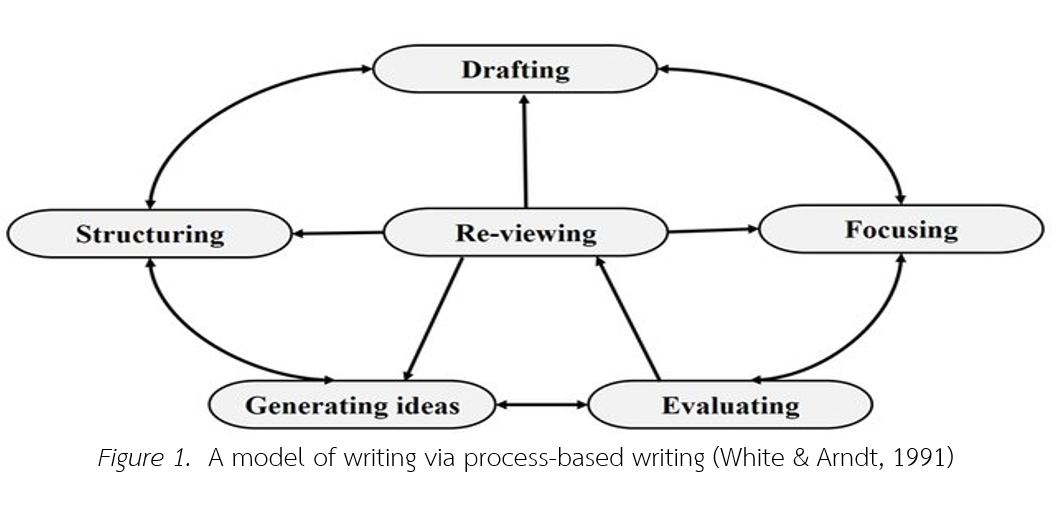Process-Based Writing Approach: A Panacea to Improve Thai Chinese as a Foreign Language (TCFL) Learners’ Writing Skill and to Eradicate Writing Block
Main Article Content
บทคัดย่อ
บทบาทของแนวทางการเขียนตามกระบวนการได้รับการยอมรับมากขึ้นในฐานะการสอนการเขียนในการช่วยผู้เรียนในการเขียนเรียงความในบริบทของการศึกษาระดับอุดมศึกษา อย่างไรก็ตาม ยังมีความสนใจเพิ่มขึ้นในการใช้การสอนการเขียนนี้เพื่อกำจัดบล็อกการเขียนของนักเรียน และจำเป็นต้องมีการค้นคว้าเพิ่มเติม จุดมุ่งหมายโดยรวมของการศึกษาในปัจจุบันคือเพื่อตรวจสอบผลกระทบของการสอนการเขียนแบบอิงกระบวนการต่อประสิทธิภาพการเขียนของนักเรียนชาวไทย ภาษาจีนในฐานะภาษาต่างประเทศ (TCFL) นอกจากนี้ การศึกษาครั้งนี้มีวัตถุประสงค์เพื่อกำจัดบล็อกการเขียนของนักเรียน ประเภทของการวิจัยแบบอธิบายแบบผสมตามลำดับถูกนำมาใช้ในการศึกษาโดยใช้การออกแบบก่อนและหลังการทดสอบ นักศึกษามหาวิทยาลัย TCFL ชั้นปีที่ 1 กลุ่มเดียวจำนวน 28 คนได้รับเลือกให้เป็นผู้เข้าร่วมแบบเจาะจงและเข้ารับการอบรม 10 ครั้งในการใช้แนวทางการเขียนตามกระบวนการเพื่ออำนวยความสะดวกในงานเขียนของพวกเขา ผลลัพธ์เชิงปริมาณเผยให้เห็นความแตกต่างอย่างมีนัยสำคัญในการทดสอบก่อนเรียน (x̄ =8.93) และหลังการทดสอบ (x̄ =14.04) ประสิทธิภาพการเขียนในแง่ขององค์ประกอบการเขียน เช่น การจัดระเบียบ เนื้อหา ทรัพยากรคำศัพท์ การเชื่อมต่อเชิงตรรกะ และการใช้ภาษาจีน ตัวอักษรภาษา สำหรับผลการทดสอบของผู้เข้าร่วม ส่วนประกอบการเขียนที่ได้รับการปรับปรุงมากที่สุดคือ "เนื้อหา" ในขณะที่ "การเชื่อมต่อเชิงตรรกะ" ได้รับการปรับปรุงน้อยที่สุด นอกจากนี้ เมื่อใช้การวิเคราะห์ความแปรปรวน (ANOVA) ความแตกต่างอย่างมีนัยสำคัญระหว่างคะแนนแบบทดสอบหนึ่งกับแบบทดสอบอื่น ๆ จะถูกเปิดเผย การค้นพบเชิงคุณภาพชี้ให้เห็นว่าผู้เข้าร่วมมีความยินดีในเชิงบวกต่อการใช้วิธีการเขียนแบบอิงกระบวนการเพื่ออำนวยความสะดวกในงานเขียนของพวกเขาและเพื่อขจัดอุปสรรคในการเขียน ดังนั้น เมื่อประสิทธิภาพการเขียนของนักเรียนเพิ่มขึ้น พวกเขามักจะจัดการบล็อกการเขียนให้หมดไป ท้ายที่สุด สรุปได้ว่าวิธีการเขียนแบบอิงกระบวนการเป็นวิธีการสอนที่เป็นประโยชน์ซึ่งช่วยให้นักเรียนไม่เพียงแต่เพิ่มประสิทธิภาพการเขียนเท่านั้น แต่ยังช่วยให้พวกเขาจัดการป้องกันการบล็อกการเขียนได้อีกด้วย ดังนั้นจึงขอแนะนำว่าควรใช้วิธีการเขียนแบบอิงกระบวนการเป็นแนวทางการสอนตัวแทนในห้องเรียนการเขียน TCFL
Article Details

อนุญาตภายใต้เงื่อนไข Creative Commons Attribution-NonCommercial-NoDerivatives 4.0 International License.
เอกสารอ้างอิง
Al-Sawalha, A. M. S., & Chow, T. V. V. (2012). The effects of writing apprehension in English on the writing process of Jordanian EFL students at Yarmouk University. International Interdisciplinary Journal of Education, 1(1), 6-14.
Asriati, S., & Maharida, M. (2013). Improving the students’ writing skill by using process writing approach at the second-grade students of Smk Grafika Gowa Makassar. Exposure: Jurnal Pendidikan Bahasa Dan Sastra Inggris, 2(2), 224. https://doi.org/10.26618/ejpbi.v2i2.788
Bayat, N. (2014). The effect of the process writing approach on writing success and anxiety. Educational Sciences: Theory & Practice, 14(3), 1133-1141.
Brown, H.D. (2001). Teaching by principles: An interactive approach to language pedagogy (2nd ed.). New York: Addison Wesley Longman.
Cando Guanoluisa, F., Campaña Pallasco, G., & Panchi Herrera, D. (2017). Students’ perception about the writing instruction in English classes. Dominio de Las Ciencias, 3(4), 902–944.
Creswell, J. W., & Plano-Clark, V.L. (2011). Designing and conducting mixed method research. (2nd ed.). Thousand Oaks, CA: Sage Publications, Inc.
Dewi, U. (2021). Students’ perceptions: Using writing process approach in EFL writing class. AI-Ishlah: Jurnal Pendidikan, 13(2), 989-997. https://doi.org/10.35445/alishlah.v13i2.555
Dornyei, Z. (2005). The psychology of the language learner: Individual differences in second language acquisition. Mahwah, NJ: Lawrence Erlbaum.
Horwitz, E.B., Stenfors, C., & Osika, W. (2013). Contemplative inquiry in movement: Managing writer’s block in academic writing. International Journal of Transpersonal Studies, 32(1), 16-26. https://doi.org/10.24972/ijts.2013.32.1.16
Imelda, Cahyono, B. Y., & Astuti, U. P. (2019). Effect of process writing approach combined with video-based mobile learning on Indonesian EFL learners' writing skill across creativity levels. International Journal of Instruction, 12(3), 325–340. https://doi.org/10.29333/iji.2019.12320a
Lachs, J. (2018). The psychology of writers’ block (and how to overcome it). Retrieved from https://www.opencolleges.ed.au/informed/featrures/psychology-writers-block-overcome.
Lee, S. & Krashen, S. (2003). Writer’s block in a Chinese sample. Perceptual and Motor Skills, 97, 537-542
Lee, S.Y. (2005). Facilitating and inhibiting factors in English as a foreign language writing performance: A model testing with structural equation modelling. Language Learning, 55(2), 335-374.
Lei, L., & Wei, Y. (2007). An empirical study on writer’s block of Chinese EFL learners at the tertiary level. CELBA Journal, 30(5), 13-18.
Lei, L. & Wei, Y. (2005). Exploratory factor analysis and applied linguistics research in China: A review, English Education in China, 3(4), 62-66
Loh, E.K.Y. & Krashen, S. (2015). Patterns in PIRLS performance: The importance of liking to read, SES, and the effect of test prep. Asian Journal of Education and e-Learning 3(1). http://ajouronline.com/index.php?journal=AJEEL
Karahan, B. U. (2021). The relationship between secondary school students’ writing attitudes and anxiety and writing disposition. International Journal of Education and literacy Studies, 9(2),136-41.
Karatay, H. (2011a). Surec temelli yazma modelleri: Planh yazma ve degerlendirme. M. Ozbay (Ed). Yazma egtimiicinde (s. 21-43). Ankara: Pegem Akademi.
Krashen, S., & Lee, S. Y. (2004). Competence in foreign language writing: Progress and lacunae. Literacy across cultures, 12(2), 10-14. https://wwwsdkrashen.com/
Malmir, A., & Khosravi, F. (2018). The effect of argument mapping instruction on L2 writing achievement across writing tasks and writing components: A case of Iranian EFL learners. Applied Research on English Language, 7(4), 515-540.
Miftah, M. Z. (2015). Through writing process approach. Journal of English as a Foreign Language, 5(1), 9–24. Retrieved from url: http://e-journal.iain-palangkaraya.ac.id/index.php/jefl%0A
Rahmat, N. H. (2020). Thinking about thinking in writing. European Journal of Literature, Language and Linguistics Studies, 3(4), 20-37.
Rahmat, N. H., Othman, N. A., Mohd Kassim, A. A., Khairuddin, Z., & Aripin N. (2019). The cycle of self-fulfilling prophecy. European Journal of Education Studies, 5(11), pp 255-269.
Richards, R. C. (2020). Understanding why students avoid writing. LD Online. Retrieved from http://wwwIdonline.org/article/5892.
Robillos, R. J. (2021). Learners' writing skill and self-regulation of learning awareness using computer-assisted argument mapping (CAAM). Teaching English with Technology, 21(4), 76-93.
Robillos, R.J. & Phantharakphong, P. (2020). Enhancing EFL learners’ argumentative abilities in written composition and critical thinking dispositions through argument mapping within metacognitive approach. Asian EFL Journal, 27(3), 181-208.
Robillos, R.J., & Thongpai, J. (2022). Computer-aided argument mapping within metacognitive approach: Its effects on EFL learners’ argumentative writing skill and self-regulation of learning. LEARN Journal: Language Education and Acquisition Research Network, 15(2), 160-186.
Rofiqoh, M., & Chakim, N. (2020). Students' perceptions on written and oral feedback in writing class. Retain, 8(2), 57–65.
Rose, M (1984). Writer’s Block: The cognitive dimension. Carbondale, Southern Illinois University Press.
Rose, M. (1983). Cognitive Dimension of Writer's Block. Carbondale, Illinois: Southern Illinois University. ERIC veri tabanından erişildi. (Eric Reproduction Service No. ED230932). http://files.eric.ed.gov/fulltext/ED230932.pdf adresinden erişildi.
Salem, M.S. (2018). Engaging ESP university students in Flipped classrooms for developing functional writing skills, HOTs, and eliminating writer’s block. English Language Teaching, 11(12), 177-198.
Sapiurka, M. (2015). Coming Up Blank: The Science of Writer’s Block. The Conversation.
Retrieved from http://theconversation.com/coming-up-blank-the-science-of-writersblock-.
Simpson, A. (2013). A process approach to writing. Retrieved January 2021, from http://www.developingteachers.com.
Syarofi, A., Kuswahono, D., & Rizky, H. (2018). Implementing process writing strategy using weblogs to improve students' ability in writing descriptive text. Lingua Cultura, 12(4), 351. https://doi.org/10.21512/lc.v12i4.4142
White, R. & Arndt, V. (1991) Process writing. London and New York: Longman.
Yaylı, D. (2009). Hizmet öncesi Türkçe ögretmenleri ile bir süreç yazma uygulaması. XVIII. Ulusal Egitim Bilimleri Kurultayı, Ege Üniversitesi, Izmir.
Zen, D. (2005). The process approach to ESL/EFL writing is a movement to process approach in ESL writing. The Journal of Asia TEFL, 2(1), 191–198.
Zhang, H. (2011). A study on ESL writing anxiety among Chinese English Major- Causes, effects and coping strategies for ESL writing anxiety. Kristiansan University of Sweden.
Zhang, D. (2009). Essay writing in a Mandarin Chinese WebCT discussion board. Foreign Language Annals, 42(4), 721e741


